 |
 |
 |
| |
48-Week Results from BENCHMRK-2, a Phase III Study of Raltegravir (RAL) in Patients Failing Antiretroviral Therapy (ART) with Triple-Class Resistant HIV-1
|
| |
| |
Reported by Jules Levin
CROI 2008, Boston
R. Steigbigel1, P. Kumar2, J. Eron3, M. Schechter4, M. Markowitz5, M. Loutfy6, J. Zhao7, R. Isaacs7, B-Y. Nguyen7, H Teppler7 for the BENCHMRK-2 Study Group
1SUNY at Stony Brook, NY, USA; 2Georgetown University Medical Center, Washington, DC, USA; 3University of North Carolina, NC, USA; 4Universidade Federal do Rio de Janeiro, Brazil; 5Aaron Diamond Research Center, NY, USA; 6University of Toronto, Canada; 7Merck Research Laboratories, West Point, PA, USA.
AUTHOR CONCLUSIONS
In HIV-infected, treatment-experienced patients failing antiretroviral therapy with triple-class resistant HIV:
· Raltegravir 400 mg b.i.d. plus OBT has potent and superior antiretroviral and immunological efficacy compared to placebo plus OBT, which is sustained through Week 48.
- In patients receiving new, active antiretroviral therapies in OBT, up to 89% achieved HIV RNA < 50 copies/mL at Week 48.
· Virologic failure is generally associated with mutations at one of two primary residues, Q148 or N155, in combination with at least one other mutation.
· Raltegravir 400 mg b.i.d. plus OBT is generally well tolerated, as compared to placebo in combination with OBT.
- Few adverse events leading to discontinuation.
-- Risk of developing malignancy is comparable between raltegravir and comparator groups, whether only the Phase III data are examined, or all Phase II and Phase III data are included.
ABSTRACT
Background: In 3 studies of HIV-infected patients (pts) with limited treatment options, RAL combined with optimized background therapy (OBT) was generally well tolerated and provided superior viral suppression for ³24 weeks compared to OBT alone. Here we present the 48-week results from BENCHMRK-2 (Protocol 019), an ongoing double-blind Phase III study being conducted in North and South America.
Methods: Pts failing ART with triple-class resistant HIV were randomized 2:1 to oral BID RAL 400 mg or placebo (PBO). All pts received OBT. Prespecified efficacy endpoints included % pts with HIV RNA levels <400 and <50 copies/mL, and the mean change in CD4 cell counts from baseline.
Results: Baseline characteristics were similar in the RAL and PBO groups. At baseline, median CD4 counts were 102 and 132 cells/mm3, and geometric mean viral loads were 4.7 and 4.7 log10 copies/mL in the RAL and PBO groups, respectively. Genotyping demonstrated that OBT contained <1 active drug (sensitivity score = 0) in 20% and 27% of pts in the RAL and PBO groups, respectively. Preplanned 48-week efficacy analyses are shown below
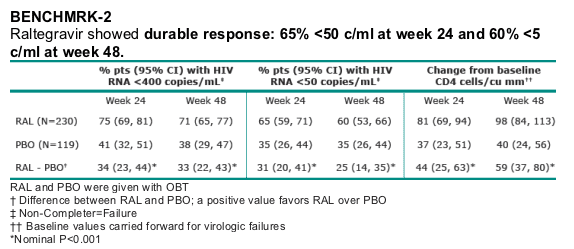
RAL was generally well tolerated over 48 weeks.
Conclusions: In this pivotal study of pts failing ART with triple-class resistant HIV, RAL plus OBT maintained superior antiretroviral and immunological responses compared to OBT alone for at least 48 weeks.
Background
Raltegravir (MK-0518, ISENTRESSTM) is an HIV-1 integrase strand-transfer inhibitor (InSTI) with
· Potent in vitro activity:
- IC95 = 31 nM ± 20 nM (50% human serum)
- Active against multi-drug resistant HIV-1, CCR5 and CXCR4 tropic HIV-1
- HIV resistant to raltegravir remains sensitive to other ARTs
- Additive/synergistic with NRTIs, NNRTIs, PIs, and enfuvirtide
· Clinical efficacy when used in combination with OBT:
- in ART-naive patients, 83 - 88% had HIV RNA < 50 copies/mL at Week 48 (Markowitz et al, JAIDS 2007; 46:125-33)
- In patients failing therapy with triple class resistant virus:
_ 56 - 67% had HIV RNA < 50 copies/mL at Week 24 in the phase II dose-ranging study (Grinsztejn et al, LANCET 2007; 369:1261-69)
_ 63% had HIV RNA < 50 copies/mL at Week 24 in the phase III BENCHMRK-1 and 2 studies combined (Kumar et al, EACS Oct 2007)
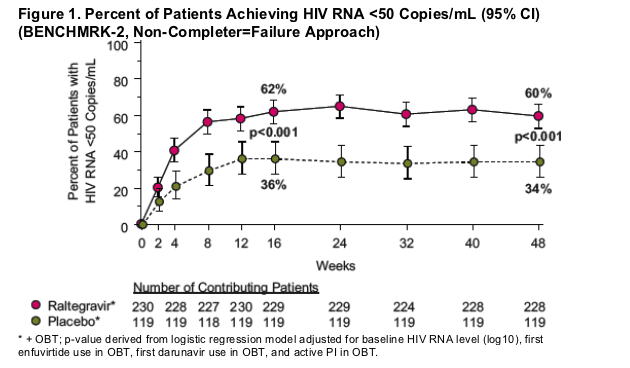
At week 48, HIV RNA <400 copies/mL was achieved in 71% of the raltegravir group vs 38% of the placebo group (p<0.001).

For a comprehensive assessment of risk, a similar analysis was done including all double blind data from Phase II and Phase III studies (Protocols 004, 005, and BENCHMRK-1 and -2), which provides a malignancy rate of 2.2/100 PYR for raltegravir and 1.8/100 PYR for the comparator group, resulting in a relative risk (95% CI) of 1.2 (0.4, 4.1).
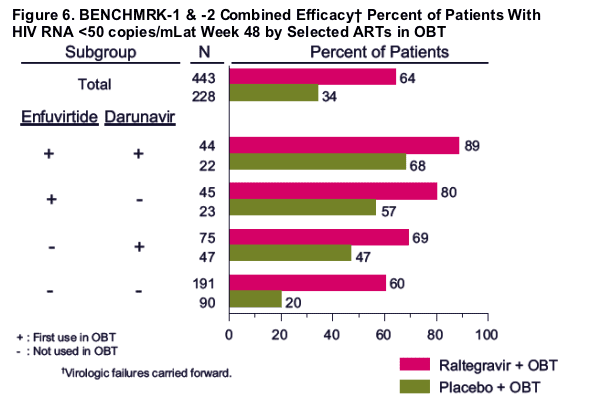
Data from BENCHMRK-1 & -2 combined
Efficacy by Subgroups
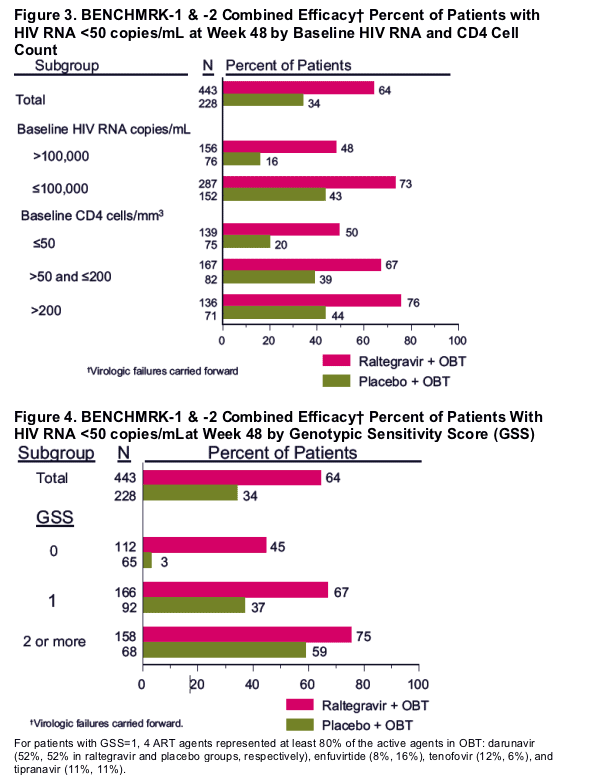
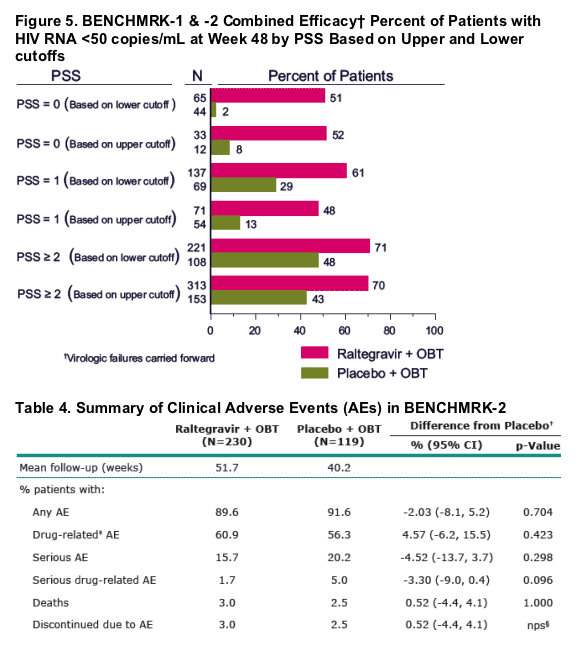
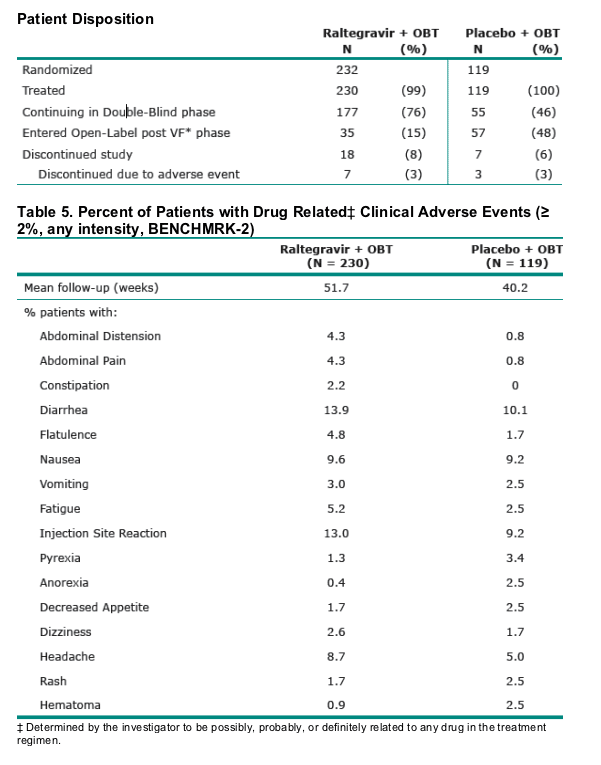
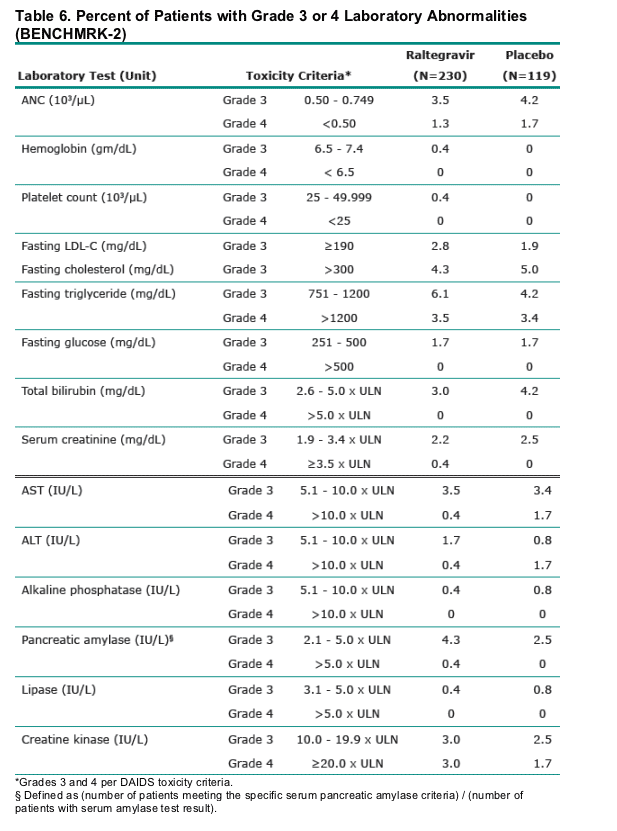
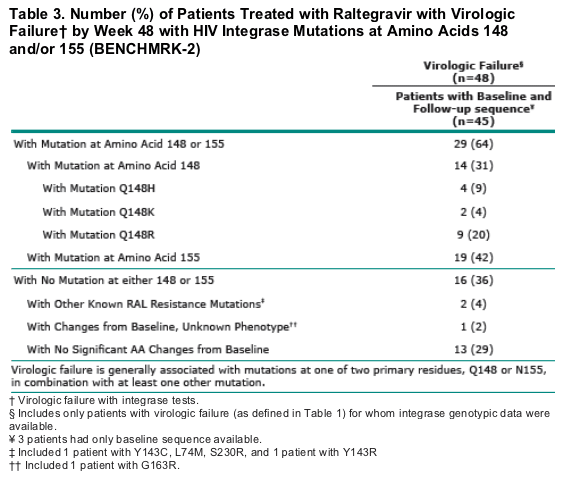
Statistical Analysis
· The durability of antiretroviral and immunological activity was assessed by the following predefined endpoints measured at Week 48: HIV RNA <50 copies/mL, HIV RNA <400 copies/mL, change from baseline in plasma HIV RNA (log10 copies/mL), and change from baseline in CD4 cell count (cells/mm3).
· For binary endpoints (proportions) over time analysis, Non-Completer = Failure (NC=F) is applied for missing data approach.
· For change from baseline in log10 HIV RNA and change from baseline in CD4 cell counts, Observed Failure (OF) approach assumes baseline value was carried forward for virologic failures.
· Data from BENCHMRK-1 & 2 were combined for additional analyses:
_ Efficacy by subgroups Ñ OF approach (virologic failure carried forward) used for missing data.
_ Cancer events Ñ time adjusted analysis based on all treated patients as they were originally randomized.
|
| |
|
 |
 |
|
|